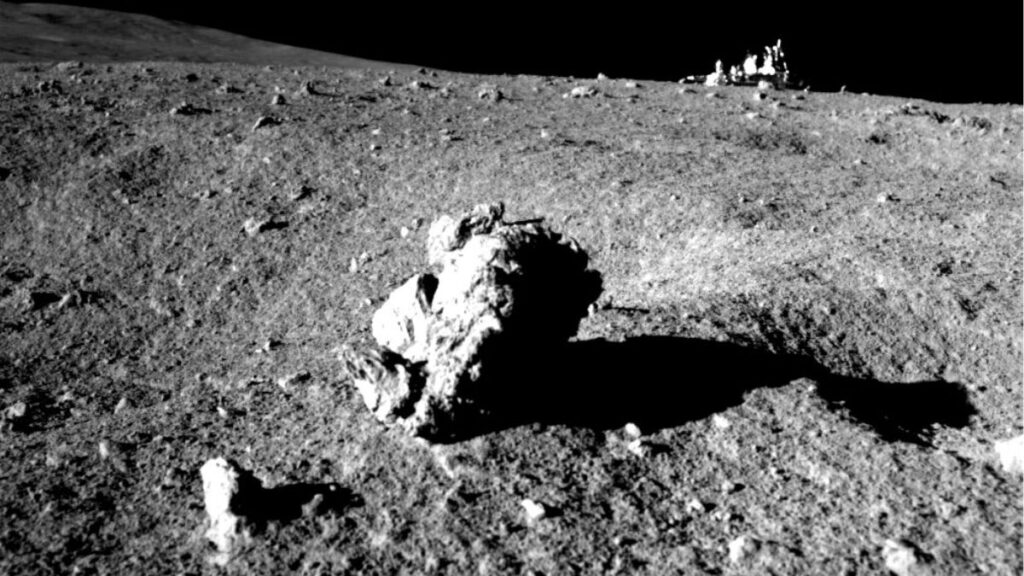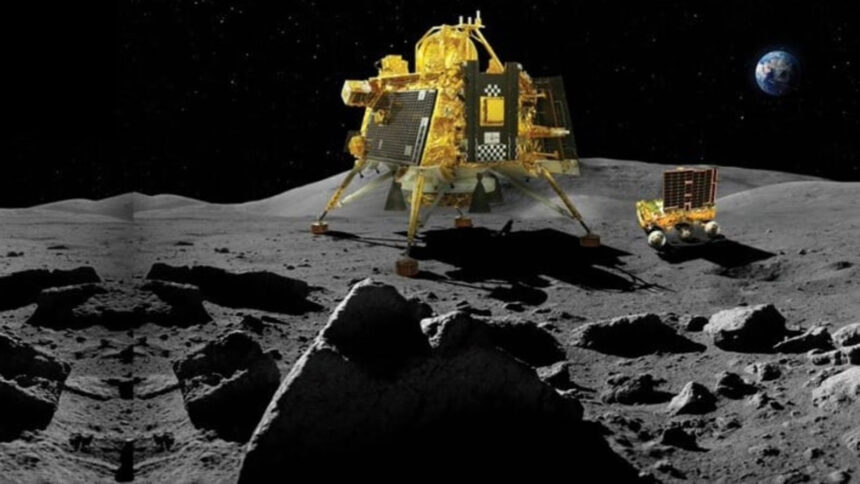As India celebrates its first National Space Day, the Indian Space Research Organisation (ISRO) has released a stunning set of images from the Chandrayaan-3 mission, marking the first anniversary of its historic landing on the Moon. These images, taken by the Vikram lander and Pragyan rover, provide an in-depth look at key moments from the mission, highlighting the challenges and triumphs faced by the team, especially in the uncharted territory near the Moon’s South Pole. This monumental event underscores India’s burgeoning presence in the global space community, further solidifying its reputation as a leading player in space exploration.
New Insights from Chandrayaan-3’s Cameras
The recently released images from the Chandrayaan-3 mission showcase the detailed visuals captured by the Vikram lander and Pragyan rover. Among these, one particularly notable image depicts the Pragyan rover’s attempt to leave an imprint of India’s national emblem on the lunar surface. Although this endeavour was only partially successful due to the unexpected texture of the lunar soil, it symbolizes the indomitable spirit and ambition of India’s space program. The images serve as a visual testament to the mission’s overall success and the complexities involved in exploring the relatively uncharted lunar South Pole.
The challenges faced by Chandrayaan-3 highlight the intricate nature of space exploration. The lunar South Pole, a region that remains largely unexplored, presents unique difficulties due to its extreme temperatures and irregular terrain. Despite these challenges, the mission’s achievements have far outweighed the setbacks, providing valuable insights into the Moon’s surface and its composition.
Supporting the Magma Ocean Theory
Beyond the captivating images, the data collected by Chandrayaan-3 has made significant contributions to our understanding of the Moon’s geological history. A recent study published in the journal Nature suggests that the Moon may have once been covered by a vast ocean of magma, a theory supported by measurements taken by the Pragyan rover as it traversed a 100-meter track on the lunar surface. This data offers new insights into the Moon’s formation and supports the hypothesis that the Moon’s surface was once molten, cooling over time to form the solid crust we see today.
The Pragyan rover’s in-situ chemical analyses have provided critical information about the Moon’s composition, contributing to our knowledge of its origin and evolution. This information is crucial not only for scientific understanding but also for future lunar exploration and potential resource utilization. As the global community continues to explore the possibilities of space colonization and resource extraction, such insights will prove invaluable.
Celebrating India’s Space Achievements

The release of these images and data coincides with India’s celebration of its first National Space Day on August 23. This day marks the anniversary of the successful landing of Chandrayaan-3 near the lunar South Pole, a feat that has placed India among the elite group of nations capable of achieving a soft landing on the Moon. As the fourth country to accomplish this milestone, and the first to do so near the lunar South Pole, India’s space achievements are a source of national pride and international recognition.
National Space Day serves as a reminder of the strides made in space exploration and the potential for future discoveries. The achievements of the Chandrayaan-3 mission underscore India’s growing capabilities in space technology and exploration. These accomplishments not only reflect the hard work and dedication of ISRO’s scientists and engineers but also inspire the next generation of space enthusiasts and researchers.
Data for Global Research
In a move that highlights ISRO’s commitment to advancing global scientific knowledge, the organization has made the scientific data gathered from the Chandrayaan-3 mission available to researchers worldwide. This data, over 55 gigabytes collected from the five payloads on the Vikram lander and Pragyan rover, offers a treasure trove of information for scientists studying the Moon and its characteristics.
ISRO Chairman S. Somanath emphasized the importance of sharing this data with the global research community. “This data is not going to be confined to those scientists who have created those instruments, but it will be made available to all the researchers of the country and the world for furthering the outcome of this,” he stated during the National Space Day celebrations. By making this data accessible, ISRO is fostering international collaboration and contributing to the collective understanding of the Moon’s geological history and potential for future exploration.
Future Missions: Chandrayaan-4 and Chandrayaan-5

Building on the success of Chandrayaan-3, ISRO is already looking ahead to future lunar missions. The designs for Chandrayaan-4 and Chandrayaan-5 have been finalized, with both missions awaiting government approval. These missions aim to further explore the lunar surface, building on the data and experiences gained from Chandrayaan-3. The continued focus on lunar exploration underscores India’s commitment to becoming a leader in space science and technology.
The upcoming missions will likely include advanced scientific instruments and payloads, designed to delve deeper into the Moon’s mysteries. By exploring the lunar South Pole and other uncharted regions, ISRO hopes to uncover new insights into the Moon’s history and its potential as a resource-rich body. These missions will also serve as a testbed for technologies and strategies that could be used in future manned missions to the Moon and beyond.
Gaganyaan: India’s First Human Spaceflight

While Chandrayaan-3 and its successors focus on lunar exploration, ISRO is also making significant progress on the Gaganyaan mission, India’s first human spaceflight. Scheduled for an unmanned test in December, the Gaganyaan mission represents a significant step forward for India’s space ambitions. All rocket stages have reportedly arrived at Sriharikota, and the crew module is currently being integrated at the Vikram Sarabhai Space Centre in Trivandrum.
The Gaganyaan mission aims to send Indian astronauts, or “Gaganyatris,” into space, marking a new era for India’s space program. The mission’s success will not only demonstrate India’s capability to send humans into space but also pave the way for future manned missions, including potential lunar landings and space station participation. The training of Gaganyatris, which includes sessions in the US and Europe, highlights India’s commitment to ensuring the success and safety of its astronauts.
SSLV: Expanding India’s Launch Capabilities
In addition to its lunar and human spaceflight missions, ISRO is also focusing on expanding its satellite launch capabilities. The successful third developmental flight of the Small Satellite Launch Vehicle (SSLV) has paved the way for the commercialisation of this technology. ISRO is transferring SSLV technology to a consortium of companies, enabling them to build and launch small satellites for various purposes.
The SSLV is designed to be a cost-effective and versatile launch vehicle, capable of carrying small payloads into low Earth orbit. Its development and commercialisation will provide India with a competitive edge in the growing market for small satellite launches. By partnering with private companies, ISRO is fostering the growth of the space industry in India, creating opportunities for innovation and economic development.
Conclusion: India’s Path to the Stars
The release of new images and data from the Chandrayaan-3 mission, coupled with the celebration of National Space Day, marks a significant milestone in India’s journey to the stars. These achievements reflect the hard work, dedication, and ingenuity of ISRO’s scientists and engineers, who continue to push the boundaries of space exploration. As India prepares for future missions, including Chandrayaan-4, Chandrayaan-5, and Gaganyaan, the country is poised to become a major player in the global space community.
India’s growing capabilities in space exploration not only enhance our understanding of the Moon and other celestial bodies but also inspire the next generation of scientists, engineers, and space enthusiasts. As the world looks to the stars, India’s space agency, ISRO, continues to lead the way, demonstrating that the sky is not the limit, but rather the beginning of an endless journey of discovery.





